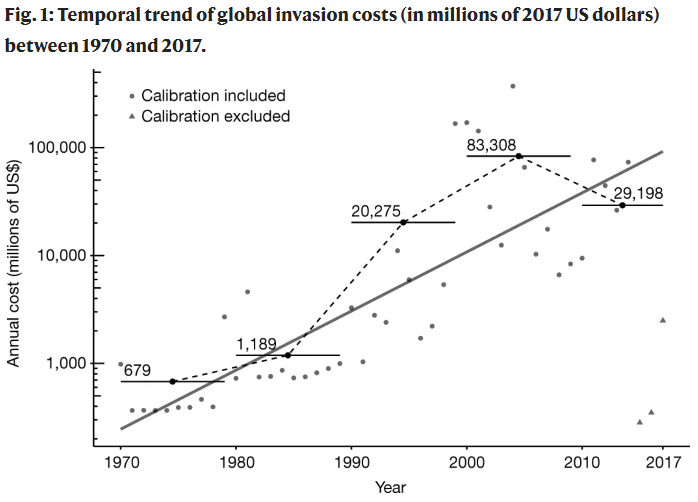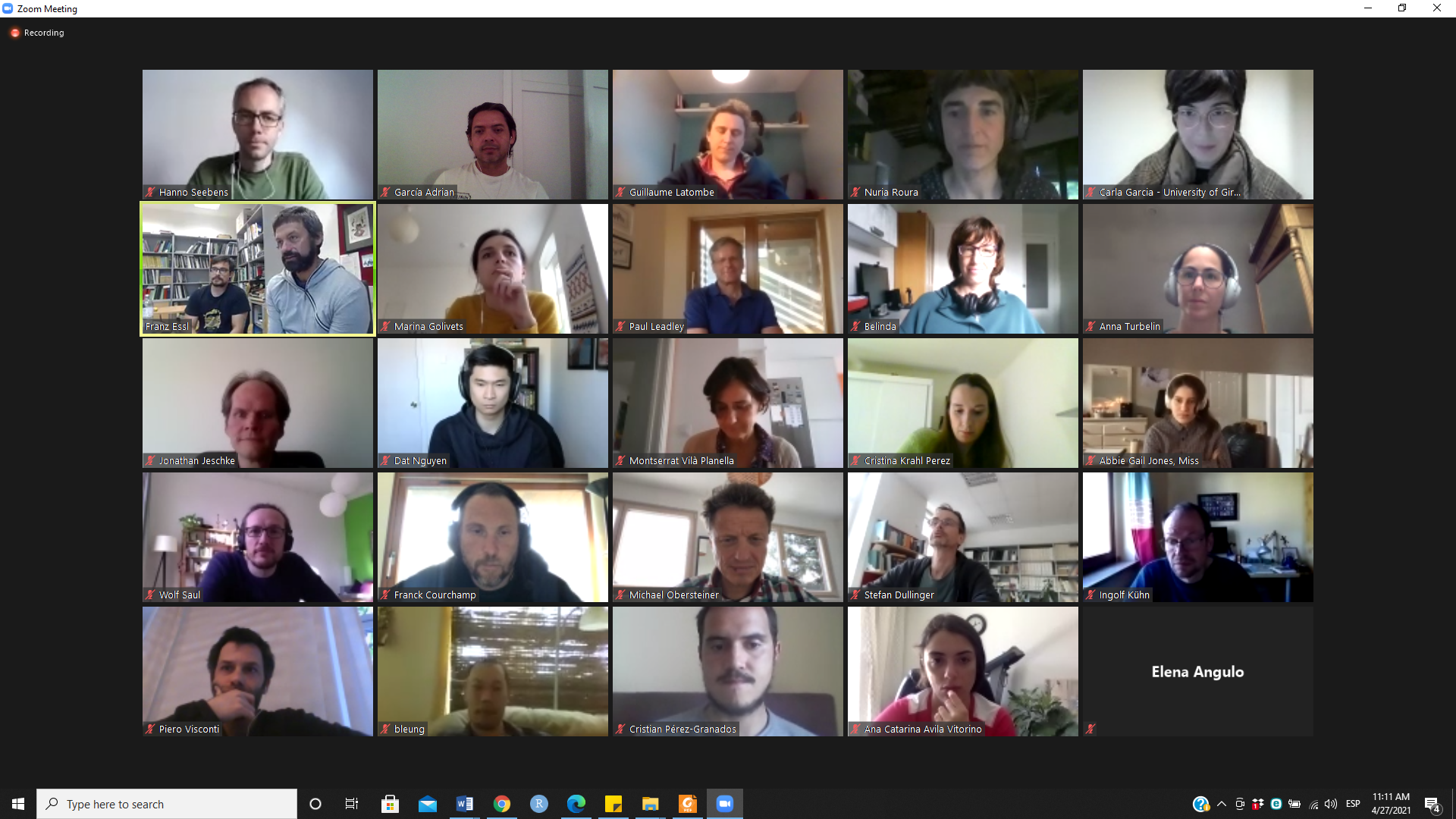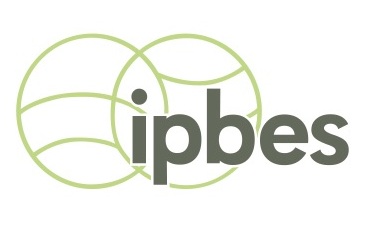
@AlienScenarios
franz.essl@univie.ac.at
bernd.lenzner@univie.ac.at
| Having trouble viewing this email? View it in your browser, or get it as a pdf. |
 |
https://alien-scenarios.org @AlienScenarios franz.essl@univie.ac.at bernd.lenzner@univie.ac.at |
|
|
|
|
|
Good
day! |
|
Global Alien Species Narratives |
The first global Alien Species Narratives have been accepted for publication in Sustainability Science. These scenarios span a wide breadth of plausible global futures through 2050 and provide a much needed first step for the quantification of different futures of biological invasions. The paper is led by Núria Roura-Pascual, and involves Franz Essl, Bernd Lenzner, Guillaume Latombe, Stefan Dullinger, Jonathan Jeschke, Hanno Seebens, Ingolf Kühn and Brian Leung from the AlienScenarios team. Until the final publication is released you can find an earlier version of the manuscript on bioRxiv. You can as well watch a talk by Núria Roura-Pascual about the paper here. |
 |
|
"High and rising economic costs of biological invasions worldwide" published in Nature |
  |
The quantification of the economic costs of biological invasions worldwide, based on the InvaCost database, has been published in Nature. Christophe Diagne led the study on the high and rising economic costs of biological invasions worldwide, which shows that "the total reported costs of invasions summed to a minimum of US$1.288 trillion (2017 US dollars) over the past few decades (1970-2017), reaching over US$160 billion for 2017 alone and doubling every six years". Alongside the paper on the global estimated costs of biological invasions, a number of targeted studies have been released, involving Christophe Diagne and Franck Courchamp: Cost of biological invasion based on non-English sources Cost of invasive aquatic species Cost of invasive ants Cost of invasive rodents Cost of invasive crustaceans Cost of invasive fish Cost of invasive bivalves Cost of invasive terrestrial invertebrates Cost of the ICUN's "100 of the world's worst IAS" Cost of invasion in protected areas Cost of delaying management Modelling the cost of invasion damages Another special issue with the focus on regional costs of biological invasions is in preparation in Neobiota and will be released soon. |
|
RETROSPECTIVE: InvasiBES annual meeting April 2021 |
|
On 19-20 April, the project InvasiBES held their bi-annual online meeting with Franz Essl (AlienScenarios PI) participation. Some exciting developments of InvasiES include: 1) developing four futures scenarios of IAS management and a master management strategy together with AlienScenarios, 2) developing a new protocol to evaluate the positive impacts that some IAS may have on native species, 3) mapping the impacts of IAS on the provision of ecosystem services in Europe, 4) evaluating the impacts associated to range-shifting species in the US, and 5) empirically evaluating the local-scale impacts on biodiversity and ecosystem functioning of the goldenrod (Solidago canadensis) in France, the Japanese wireweed (Sargassum muticum) in California, and the blue crab (Callinectes sapidus) in Spain. Future collaborations between AlienScenarios and InvasiBES, especially in terms of dissemination and fostering networking among members of the two consortia, were discussed. |
 |
|
Human infectious epidemics through the lens of biological invasions |
 |
A new article led by Montserrat Vilà and in collaboration with Belinda Gallardo, Jonathan Jeschke and Franz Essl (InvasiBES and AlienScenarios projects) investigates the synergies between concepts in invasion science and concepts related to emerging human infectious epidemics. The article highlights that fundamental concepts in invasion biology regarding the interplay of propagule pressure, species traits, biotic interactions, eco-evolutionary experience, and ecosystem disturbances can help to explain transitions between stages of epidemic spread. For instance, urban encroachment into pristine habitats brings species living there into close contact with humans. This provides ample new opportunities for pathogens to switch their host to humans, or for alien species to colonize disturbed habitats. The study highlights that forecasting and management tools used to address epidemics and biological invasions could potentially be applied in the respective other field. Cross-fertilization between the two disciplines to improve prediction, prevention, treatment, and mitigation of invasive species and infectious disease outbreaks should be highly beneficial to both disciplines. Vilà M, Dunn AM, Essl F, Gómez-Díaz E, Hulme PE, Jeschke JM, Nuñez MA, Ostfeld RS, Pauchard A, Ricciardi A & Gallardo B (2021) Viewing Emerging Human Infectious Epidemics through the Lens of Invasion Biology. Biosience, doi:10.1093/biosci/biab047 |
|
RETROSPECTIVE: Bi-annual AlienScenarios meeting April 2021 |
|
The bi-annual AlienScenarios meeting took place (online) on 27.-28.05.2021. It was a very productive meeting where each partner provided updates on the status of the ongoing work
that is pursued in the different workpackages, following by a day of creative and inspiring exchange of ideas on various topics. Key developments in the project include: - The establishment of a strong connection between AlienScenarios and the Nature Futures Framework developed by IPBES. - The first quantification of a business-as-usual scenario of biological invasions worldwide and subsequent advances in model development to integrate driver dynamics in biological invasion forcasts. - The publication of the global economic cost of biological invasions as a baseline for future quantifications projections of impacts of biological invasions. - The downscaling of the global Alien Species Scenarios to the European level with the subsequent development of management strategies involving a variety of European stakeholders. - Substantial progress in the quantification of functional traits of invasive species for future projections in trait change and their link to ecosystem services. - Substantial progress in model development of the global shipping network with special attention on the Panama canal as study system. There was as very active participation of Piero Visconti Paul Leadley, Mark van Kleunen, Aníbal Pauchard, Cang Hui and Michael Obersteiner, from the scientific advisory board and Montserrat Vilà and Belinda Gallardo, who joined the discussions. |
 |
|
RETROSPECTIVE: Nature Futures Framework Workshop January 2021 |
 |
The workshop on modelling Nature Futures scenarios organized by the IPBES scenarios and models taskforce took place on 12.-15.01.2021. The workshop provided an introduction and overview on the Nature Futures Framework (NFF) and invited participants from the modelling community to provide feedback and suggest future applications of the framework. The NFF is a tool to capture diverse, positive relationships of humans with nature with the aim to illustrate plural perspectives in the creation of desirable nature scenarios. Among the participants were Bernd Lenzner, Hanno Seebens, and two scientific advisory board members of Alien Scenarios Cang Hui and Garry Peterson, who discussed potential applications of the NFF to the new Alien Species Narratives to explore different facets of nature valuation in biological invasion scenarios. |
|
Interactions with IPBES - Invasive Alien Species Assessment |
|
AlienScenarios has developed and established strong ties to IPBES and especially to the IPBES Invasive Alien Species Assessment. Aníbal Pauchard and Helen Roy who are part of the scientific advisory board of AlienScenarios are two of the three Co-Chairs of the ongoing Invasive Species Assessment. Additionally, from the core team of AlienScenarios Franz Essl, Bernd Lenzner, Hanno Seebens and Franck Courchamp are authors, review editors and/or coordinating lead author to the assessment, ensuring a close collaboration and uptake of relevant findings like the economic impact of invasive alien species, the Alien Species Narratives, the quantification of the business-as-usual scenario or the quantification of the drivers of future biological invasions globally and on islands in the IPBES assessment. Further, in collaboration with experts of the IPBES task force on Scenarios and Models it is planned to apply the Nature Futures Framework to the Alien Species Narratives, which would ease the comparison and integration of these scenarios with global biodiversity scenario developments. Finally, Franck Courchamp has been selected as the representative for the CNRS/France to participate at the next IPBES plenary and as a reviewer of the relevant documents associated to the IPBES - IAS assessment. |

|
|
AlienScenarios early career researchers in the spotlight |
|
In
each issue of the Newsletter, we highlight early career
researchers who are part of the AlienScenarios team. In this
third issue, meet Adrián, Abbie Gail and Carla! |
 |
Adrián García-Rodríguez In May, I started as Postdoc in the Bioinvasions, Macroecology and Global Change group at the University of Vienna, Austria. I am a Costa Rican ecologist and herpetologist by training with a vast interest in biogeography, macroecology, biodiversity conservation, and evolution. I did my PhD in Brazil and recently finished a Postdoc in México. Most of my current research is focused in understanding 1) how micro- and macroevolutionary processes had shaped current spatial patterns of biodiversity and 2) how current anthropogenic pressures (e.g. diseases, biological invasions and climate change) change those patterns. In AlienScenarios I'll be involved in WP1 but open to collaborate with other WPs. During my free time I enjoy sharing with family and friends, play music and attend to live shows and discover new restaurants and craft beers. I also like to run, play and watch soccer or simply spend time outdoors and enjoy natural destinations. If I were a song, I would be Reggae fever, by Steel Pulse. If I were a painting, I would be El niño y la nube, by Francisco Amiguetti. If I were a fictional character, I would (like to) be Batman. If I were an alien species, I would be Eleutherodactylus coqui, the Common Coquí. |
| Abbie Gail Jones After completing my BSc. Honours in 2019 in the Environmental Change & Aquatic Biomonitoring Lab at Mount Allison University in my home province of New Brunswick, Canada, I began my MSc. and later transferred to a PhD. in the Leung Lab & the Pollock Quantitative Biodiversity Lab at McGill University (Montréal, Québec, Canada). I am focusing my thesis on building integrative species distribution models for the complete European Flora, taking into account pervasive spatial and taxonomical biases present in species occurrence databases using plant survey plots and species traits. In my role with AlienScenarios, in addition to working with my supervisor Brian Leung in WP6, I am collaborating with WP4 to build models assessing the signal of modern invasive species management efforts on country-wide incidences of species invasions in the past few decades. In my free time, I enjoy fishing, hiking, and biking in nature on beautiful weather days (... and playing video games or watching good movies with my friends & cat when it rains). If I were a song, I would be On Ne Change Pas by Céline Dion. If I were a painting, I would be White Cat, by fellow Atlantic-Canadian Maud Lewis. If I were a fictional character, I would be Velma Dinkley from Scooby-Doo. If I were an alien species, I would be Osmerus mordax (Rainbow Smelt... what better fish to brace the winter cold to ice fish!). |
 |
 |
Carla García-Lozano I am a postdoc in the Animal Biology Research Group at the Environmental Science Department of the University of Girona. I am involved in the AlienScenarios project trying to understand the management of invasive alien species at different spatial scales, knowing the opinion of different stakeholders. My doctoral thesis project focuses on the beach-dune systems of the Catalan coast and I designed a set of indicators to analyse the geomorphological and ecological status of the beach-dune systems to quantify their potential for dune restoration. The results of my PhD contributed to perform the most complete catalogue of dune beaches in Catalonia in a dynamic web map format (www.platgesonline.cat) that includes data about the plant biodiversity of dune-systems in Catalonia. Since I finished my doctorate, I worked as Geographical Information Systems and Remote Sensing technician at SIGTE from the UdG. In addition, I participated in management projects on beaches that allowed me to identify invasive species and recommend their removal. If I were a song, I would be Love me or leave me, by Nina Simone. If I were a painting, I would be Volcano, by Sephen Wiltshire. If I were a fictional character, I would (like to) be Nobita Nobi (Doraemon). If I were an alien species, I would be Arundo donax. |
 |
 |
|
Contact Us Visit us on the web at https:\\alien-scenarios.org |
If you no longer want to receive our emails, you can un-subscribe here. |